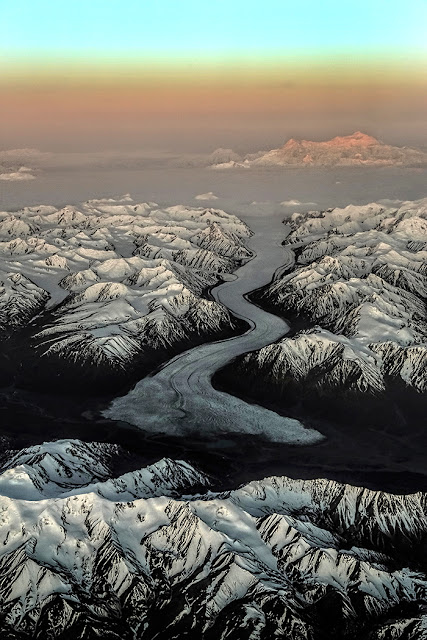 |
| Cover image of Earthforms: Intimate Portraits of Our Planet |
The book measures 11" X 11" and is 152 pages. It begins with a dedication by the author that pleads for a much more responsible approach to modern development and an examination of profit motives. This is followed by a foreword by Daniel Sheehan called, Still Standing: The North Dakota Access Pipe Line Court Cases and the Future of Freedom. Those who lean on the conservative side of the political spectrum will find this piece difficult to read, for its honest assessment of the future of fossil fuels. But I found it fascinating as it outlined a timeline of events that began in 2015 for the building of an oil pipeline from North Dakota to the Gulf states. The legal system is certainly set up to dismiss the concerns of the indigenous people who live near the proposed pipeline. It is a powerful read.
One of the innovative inclusions in the book is found on the inside of the front cover. It is the geologic time scale that runs across the width of a 21-inch spread. Colors effectively differentiate the various Eons, Eras, and Periods of the time scale but what sets this apart is that a page number corresponding to a photograph in the book is placed in the time-appropriate location on the time scale. Unfortunately, not all of the photographs are listed this way (I wonder why the exquisite photographs of The Wave at Coyote Buttes were not placed in the Jurassic)? However most of the photographs are listed here and for any geologist who might be interested in this book, this is a wonderful and helpful addition.
I am not generally enamored with close-up photography of geologic features. But I have to admit that this photograph, called Tafoni Subdivided, is striking and there are a variety of photographs similar to this within the book. This photograph was taken at Salt Point State Park located between Bodega Bay and Sea Ranch on the north coast of California. For my tastes, I prefer more of the macro-scale views of landscapes. But I also completely understand that close-ups are artistic and enjoyed by others.
This one is called Receding Glacier, and was taken in the Chugach Mountains of Alaska. The glacier is flowing toward the viewer from the mountains in the background, and spills onto a forested valley floor. The colors and contrast are warm, even though the subject matter may be deemed cold. The Chugach Mountains formed as slivers of crust were attached to the edge of the content by movement along the plate you nary here.
This is called, Mono Dusk, and was taken at Mono Lake in California. The tufa towers formed during a high-stand in Mono Lake and when calcium in solution was precipitated as subaqueous columns. They now stand high and dry near the current (2011) lake level.
This is called Alhambra Rock at Dusk, and located near Mexican Hat Utah at sunset. Alhambra Rock is a dike that was emplaced around 22 million years ago in the Navajo Volcanic Field. A more well-known feature of this field is Shiprock located in New Mexico and featured in a photograph of this book on pages 40-41.
"Earthforms: Intimate Portraits of our Planet," can be purchased on Amazon. The hard copy sells for $39.95 plus shipping. The eBook sells there for $9.99. You can also purchase directly from the authors website at earthforms.net for $35 plus shipping. More sample images from the book can be viewed on this website and even more are located on the authors Instagram page - joelsimpsonphoto.
Congratulations to Dr. Joel Simpson on the release of his new book. There are many excellent photographs from around the world - internationally from Madagascar, Sardinia, Mongolia, Jordan, Canada, Ireland, and Wales; and nationally from Idaho, Colorado, New Mexico, Arizona, and California. Although the geologic descriptions are limited, the photography is outstanding. And the intent of the book is to call attention to the harm incurred by our seemingly insatiable appetite for more of everything. Truly, the current system of consumption that is rampant in society today is unsustainable. I support any and all efforts to bring attention to this crisis in our civilization. While I do not advocate for the immediate cessation of the use of fossil fuels, I do believe that there are innumerable other ways to fuel our society and that if we do not heed this opportunity, all will be lost.




